Great Horned Owlet Transparent Watercolor and Time-lapse Video
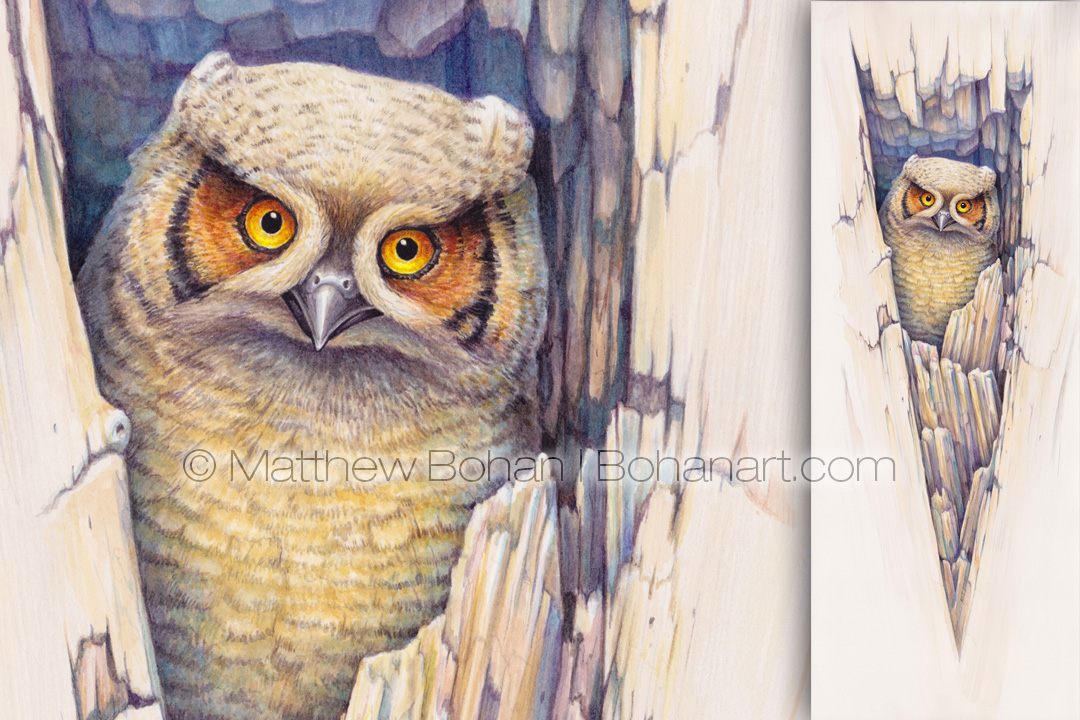
Last year on our annual pilgrimage to Crane Creek, Ohio, one of the big treats was seeing a Great Horned Owlet in its nest cavity and getting photos and video of the little “Furby.” This painting is based on those photos but departs a lot from the reference images that I took. In my effort to work outside my comfort zones, I thought I’d try to keep this looser than I normally work. Additionally, I tend to avoid white backgrounds as much as possible. This one approaches white but has a super light wash of a tan color that fades to white at the edges. In the past twenty years I think I’ve only chosen white a few times.
Owls are exciting birds. Even folks that aren’t normally “bird people” get revved up when an owl is around. I grew up on the edge of a small town in western New York. Our house was next to a big woodlot where my brothers and I spent a ton of time. One year a great big owl started frequenting a Goliath dead tree near our house. A few years later my father found an Eastern Screech Owl nest cavity deeper in the same woods. The adorable little owl stayed around that hole most of the summer and fall.
Seeing an owl isn’t that uncommon, but there is still something special about any owl encounter. Over the years our yard has hosted Barred, Great Horned and Eastern Screech Owls at different times. Mostly we have heard them calling rather than seen them, which is a little less thrilling but still great fun.
Shared Interests: White-breasted Nuthatch and Downy Woodpecker Watercolor and Time-lapse Video
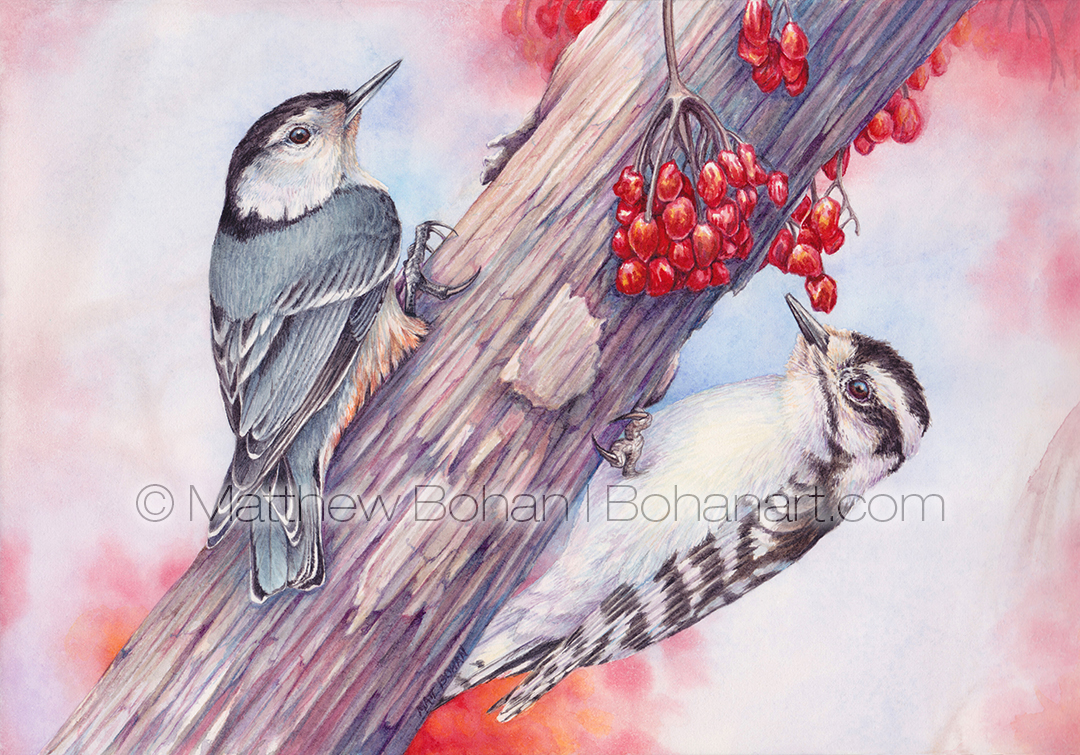
I’m not much for imaginative names for paintings. I tend to go for the obvious. Most often I only have one species in a painting, which helps simplify things. This painting ended up having two species, which would’ve made the name too long. In general I think titling paintings can become ridiculous. A title makes it handy to identify a painting within a body of a work, but it really has no impact on the painting itself. Occasionally the title provides a frame of mind to view the painting in and may provide some insight into what the artist intended. It makes more sense for abstract paintings. A good example is I Saw the Figure Five in Gold by Charles Demuth, which references the poem The Great Figure, by his friend William Carlos Williams. In this case, knowing what he was inspired by raises an already great painting to an even higher level.
In most cases I’m under the suspicion that artists give extraordinary names to “under-ordinary” works to compensate a bit. In an art school painting class, I remember a student saying with dramatic flair before his final project was critiqued, “I call this piece Oppression.” His project was an installation-ish piece which had a barbecue grill in front of a tarp that was lightly splattered with paint. Some paint-covered rags lay around it, and several Krylon spray painted corn cobs were plopped randomly on the grill. The professor said, “Yeah… I don’t really care what you call it. It shouldn’t matter. A piece should stand on its own.” He paused a few LONG minutes while looking at it and then said, “This is supposed to be a final project for a painting class. I don’t see a lot of paint here.” I can’t imagine that the student got a good grade. Maybe he should’ve called it Bar-B-Q?
We often have birds jockeying for position at our feeders, especially the suet feeders, which I make out of hollowed out logs like the one in the painting. It isn’t unusual to see birds fighting over one of the logs. Nuthatches put up a great show, at times flaring out their feathers to look bigger and flipping their heads from side to side like a cobra. My initial thought was to call this The Standoff but thought I’d go with Shared Interests, since they don’t seem overly aggressive with each other. But the name really shouldn’t matter…
I started this painting planning to hold back on the palette, the contrast and the saturation. I wanted a soft background that was still “washy.” I tend to use a lot of saturated color and a wide palette, so this involved working out of my comfort zone a bit. As the painting went along, I did boost the saturation in the reds and shadows, but I think that on the whole I was able to restrain myself. I bragged up the colors in the log a lot but kept them all in the same basic color scheme, so I’m happy with the result.
The original painting is available in my Etsy shop… have a peek!
Song Sparrow Transparent Watercolor
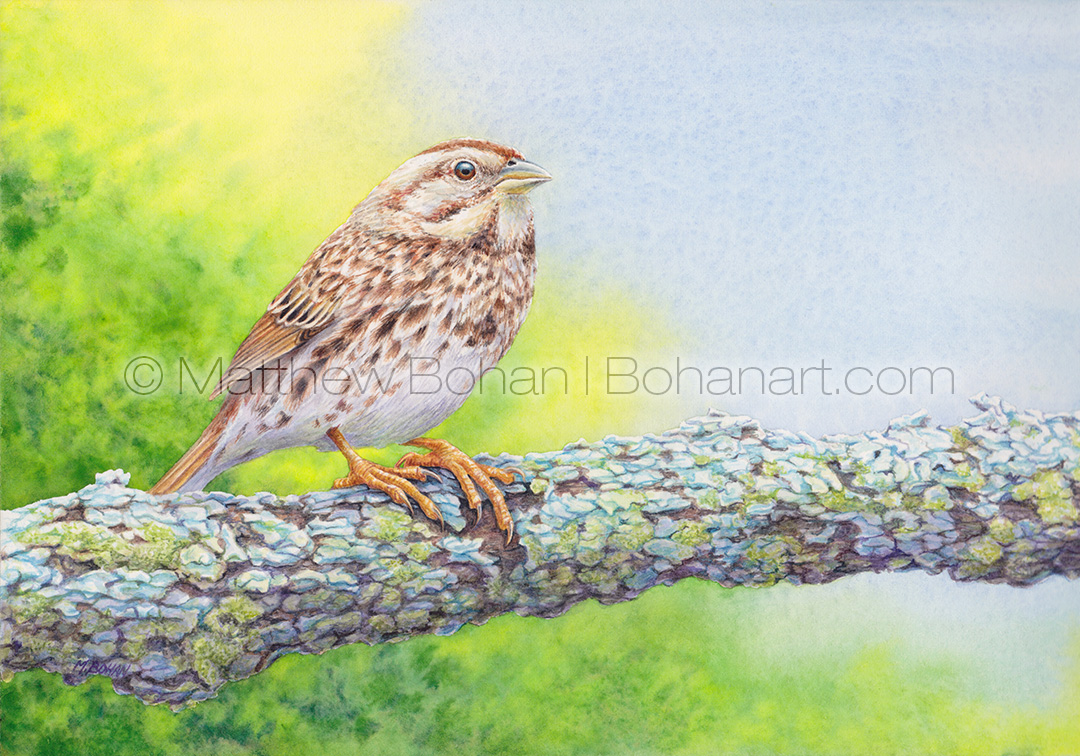
Song Sparrows sure seem to be friendly little birds. Their cheery “Madge-Madge-Madge, put-on-your-tea-kettle-ettle-ettle” call is always a welcome sound. We get them in our yard frequently, but in really low numbers. I don’t think I’ve ever seen more than one at a time. We’ve been lucky to know a couple on a more personal level.
A few years ago we had an individual that seemed to have a broken wing. The poor thing couldn’t fly and held its wing drooped down all the time. It would visit under our bird feeder, then hop its way over to the safety of the nearby hedge. For weeks it went on, and miraculously the little trooper evaded the Cooper’s Hawk and neighbor’s cats. The kids took to calling it “Bounce SOSP” (SOSP is the bird banding code for Song Sparrow). Though its color and feathering looked great, weeks went by with no visible improvement to its wing. The little guy seemed to be happy enough, calling all the time. As the summer moved on, Bounce SOSP was gradually able to lift its wing up, and when hopping around the lawn, it would add in a tiny flutter and short glide here and there. As late summer started got underway, the bird was taking short flights to and from the hedge. By fall our little hero was flying around like nothing had ever happened. What a huge relief! Eventually, it migrated. Though sad to see it go, we were glad it had that option. Every summer since then we have had a Song Sparrow coming to the feeders, and we always wonder if it is the same bird. I sure hope so.
Due to a few technical problems with the camera, there is no time-lapse video for this painting. It was a fairly straightforward painting, though. The one thing that was different was that I forced myself to stop working on the background after a single wet-on-wet wash. Typically I add a few more layers to intensify and even out colors, but with this one I was happy early on and thought I’d try to leave it alone and not overwork things. Sometimes watercolor should look washy and wet! In the old days I would’ve taken out the airbrush for something like this, but I really love the granulation in the sky and subtle backruns implying foliage. What do you think?
Visit the Updated Website!
A long overdue update to website was just finished. Come on by and browse through loads of NEW animal art, medical & scientific illustration/animation as well as plenty of photography at bohanart.com.
Pied-billed Grebes Transparent Watercolor and Time-lapse Video
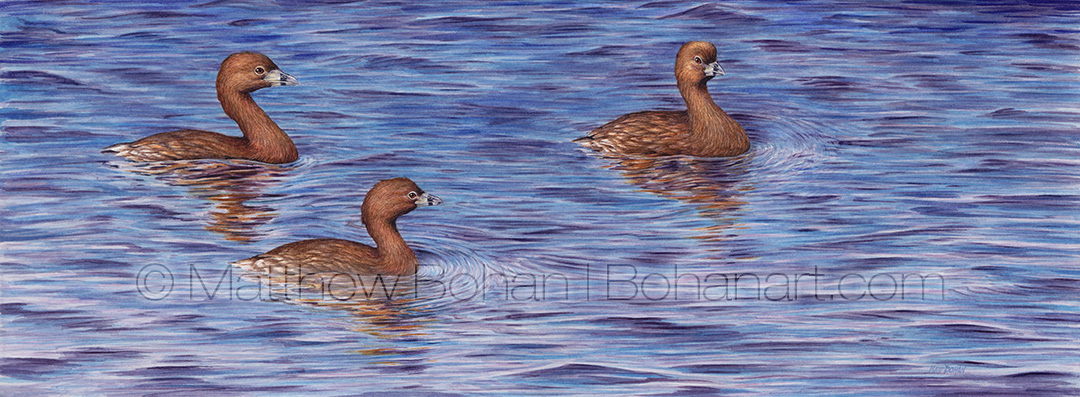

I’m still behind on posting and have been uploading things out of order chronologically. For example, I finished this watercolor before Christmas. (!)
I was looking through photos from last year’s trip to Florida and decided to do a watercolor of some Pied-billed Grebes. They are charming little birds and were the first grebes I became familiar with. I do get more excited when I see a Horned or Eared Grebe, but when I take the time to watch these little guys through binoculars or a spotting scope, I’m always reminded of how beautiful they are, even if they are a bit less flashy than their relatives.
Sometimes paintings get away from you, especially if you are trying something a little different. I was in a bit of a rush, attempting to complete this one before the holidays. It was fairly complete, but I thought it was still lacking a little “punch.” I scanned the painting and did some tests in Photoshop to see what I could do to to liven it up a little. My photos all had a very gray-white sky reflected in the water, which was sub-optimal. In the end I added some saturated colors to the water in the painting. Now that I’ve had some time away from it, I think I overdid it. Oh well… on to other projects!
Orange-crowned Warbler Transparent Watercolor and Time-lapse Video
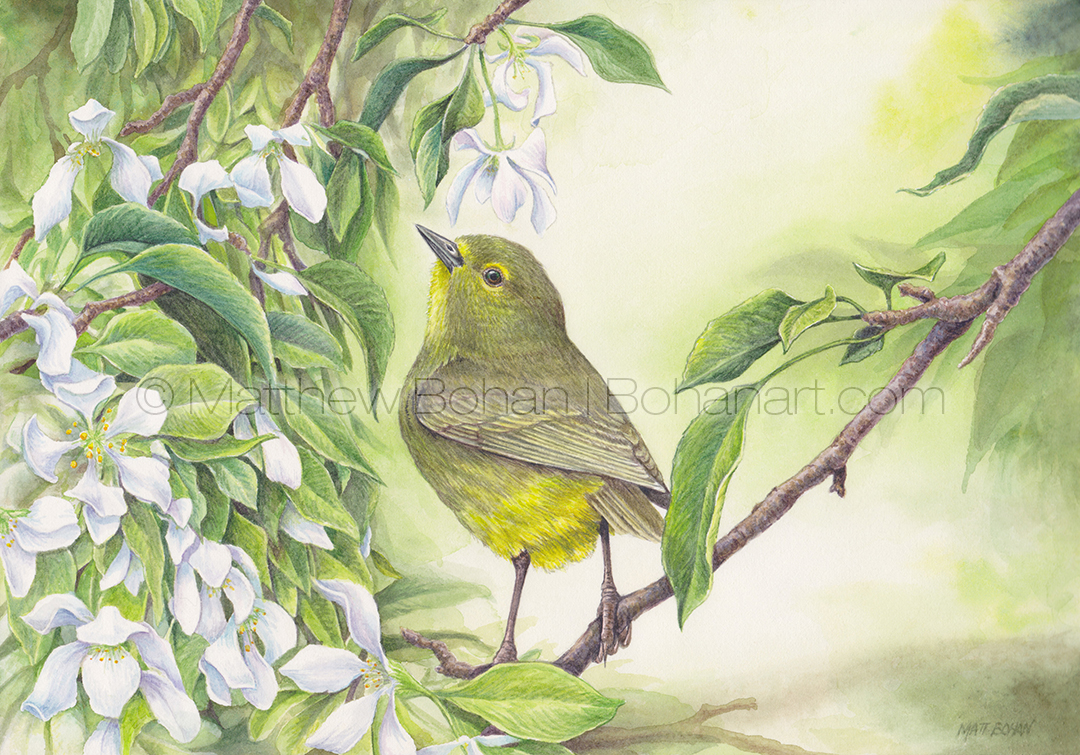
Orange-crowned Warblers are often described as drab. While they aren’t as flashy as a Hooded or Kentucky Warbler, they really are quite beautiful. It took me a long time to confidently identify them because they have so many subtle features. The past few springs we have been lucky in having Orange-crowneds visit our crabapple trees. This painting is based on photos taken from the bedroom window. The photos weren’t great but had a neat backlit look. For the painting I wanted to have a detailed foreground dissolving away to a misty background. I was trying to work outside my comfort zones, creating a looser, less saturated effect than my typical paintings.
Black-capped Chickadee in Snow Transparent Watercolor and Time-lapse Video
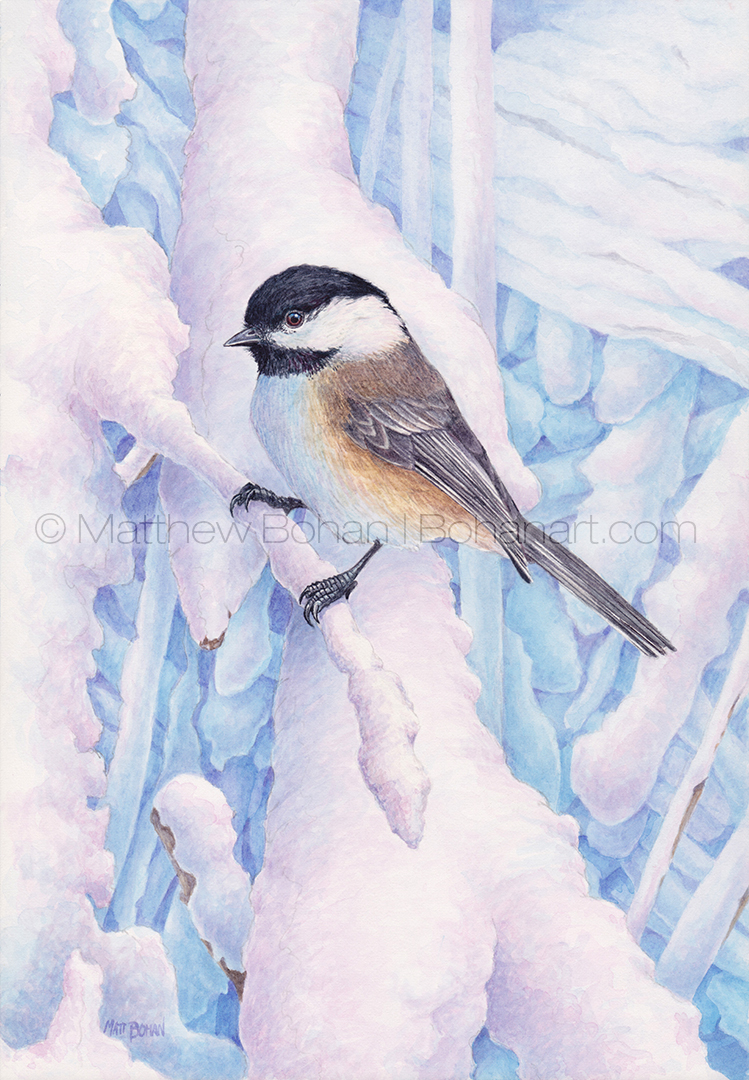

What is cuter than a Chickadee? Chickadees are incredibly common, and I’ve sketched them dozens of times, but I’ve only painted them once. Their high-contrast coloration makes them a little trickier for watercolor. For the same reason it’s hard to get a good exposure of them when photographing, scanning or printing. They are super high-contrast birds with rich blacks right next to delicate whites. In watercolor having black and white next to each other is tricky because the darker colors can lift and run into your light areas, and you can end up with a muddy mess. To keep colors crisp you are forced to paint your lights first and bring in the darks later, which makes balancing colors harder. The reason photos, prints and scans also have problems with those high-contrast areas is that you tend to expose for either lights or darks, and having to compromise results in one or both suffering in the end.
I had great photo references from a snowy day at our bird feeders. It was a lot of fun rendering the snow. One always thinks of snow as being white, but I’ve always been amazed at how many tones it can take on in different lighting conditions. I feel bad for people who have never REALLY experienced snow. On a sunny day with fresh snow, you can be treated to diamond-like refractions of sparkling snow with every color of the rainbow in tiny, intense sparks of pure color. In the evening the same snow might appear cobalt blue from the window, and at sunrise it might be pink, orange or yellow with purple-blue shadows. In this painting I had fun playing with the effect that snow has as it gets deeper and more tunnel-like, taking on a blue tint.
Birds of the Everglades Transparent Watercolor and Time-lapse
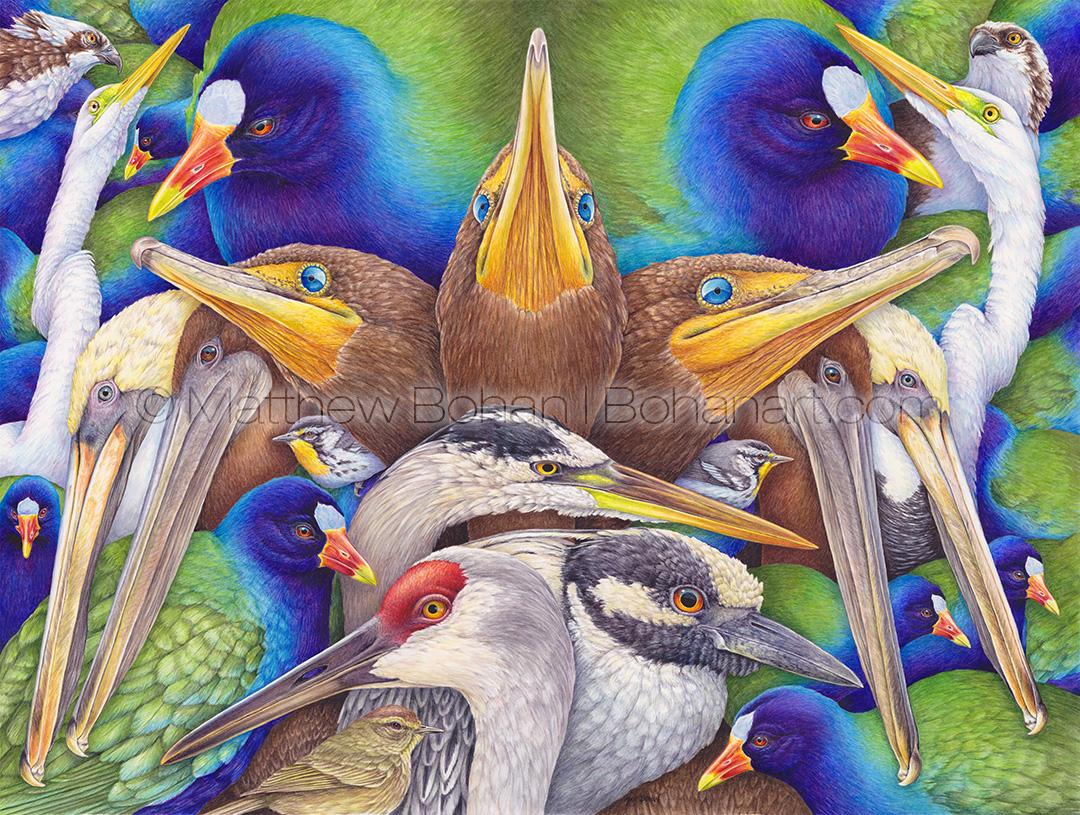

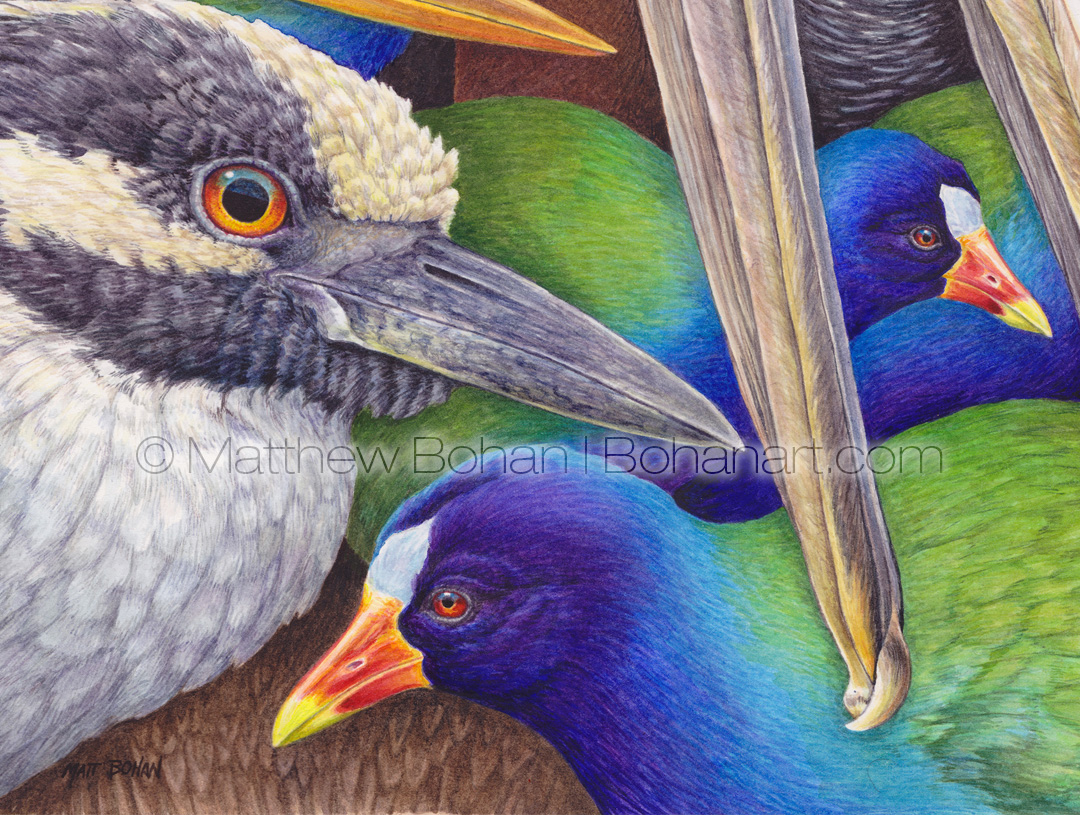
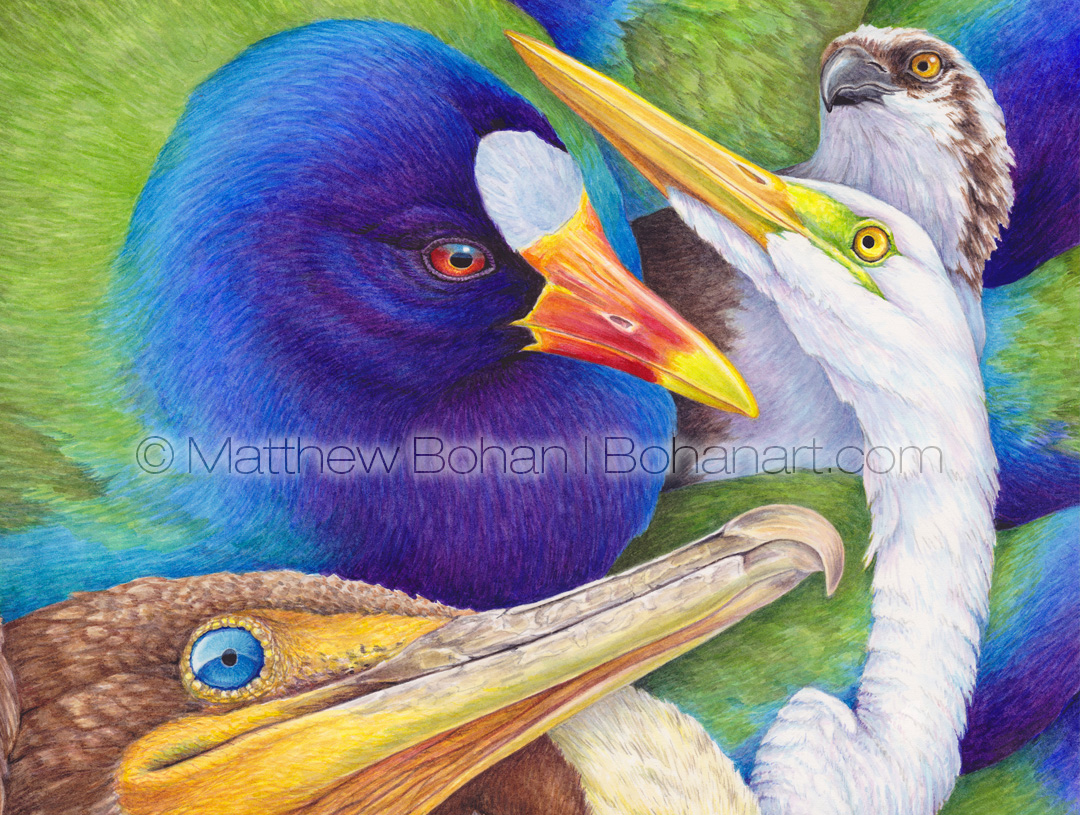
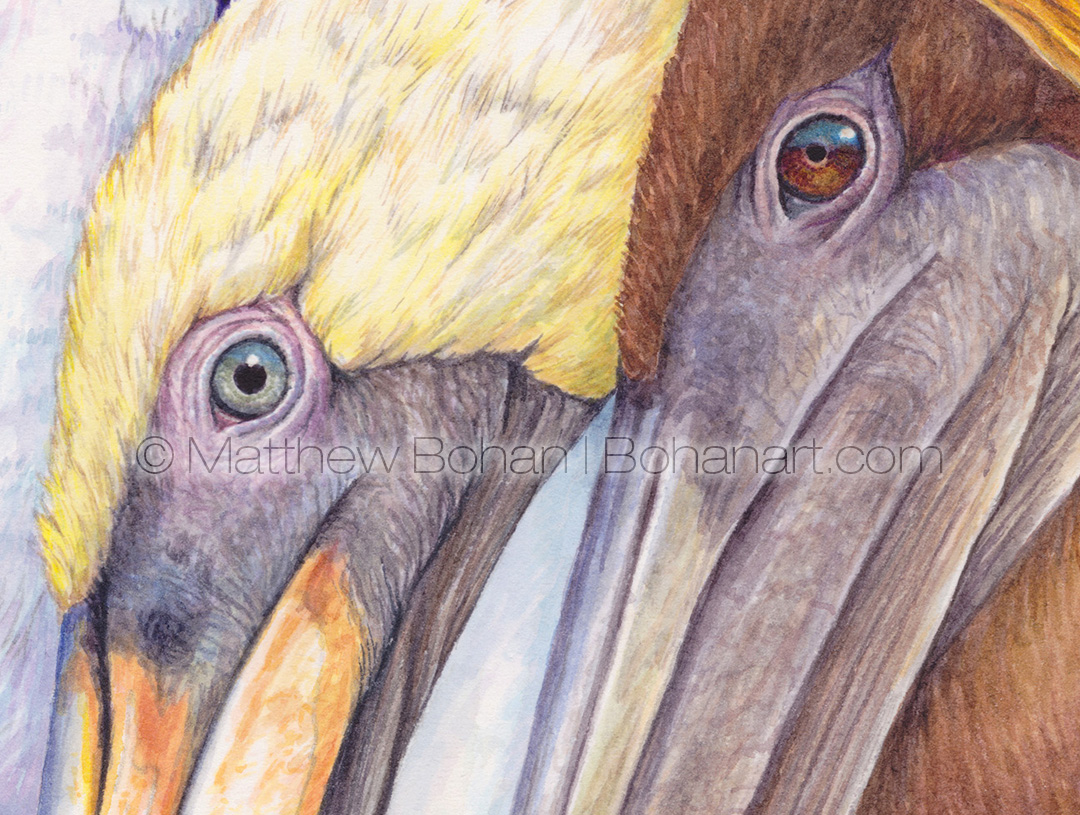
There is no way around it: this painting took an incredibly LONG time! This 18×24-inch transparent watercolor features 25 birds found in Everglades National Park. I hatched the idea for this after our family trip to the Everglades last winter. As is typical with these elaborate compilations of numerous animals, it took a few days just to come up with a composition that I thought would 1) work well and 2) be worthy of the huge amount of time it would take to complete it. Most paintings have areas with less detail, but every square inch of these is covered with detailed work. I even wore out two #2 round brushes on this one! Though these 18×24-inch watercolors look decent on larger monitors, you really need to see them at full size to appreciate the work that went into them.
When painting something so complex with so much detail, the real challenge is creating a convincing spatial relationship. It would be pretty easy to cut out birds from previous paintings and simply combine them into a digital collage in Photoshop. For me, however, the real art lies in designing the piece to maximize the interplay of shapes and color, and the real test comes when trying to paint everything on one page and have it all work together. Ultimately, I think that each of my “critters” paintings is about movement and patterns of color and texture. In a way they are abstract paintings made of real-world objects.
People occasionally say that my watercolors look like photos. I think that’s intended as a compliment, but it definitely isn’t my goal. I want them to look like paintings. I like seeing the pigments and brushstrokes here and there. Also, I’m not always 100% literal with color, and I like to keep my shadows full of color. My first painting along these lines was from 1995 or so.
My last “critters” painting was licensed by Pomegranate to be made into a 500-piece puzzle (Whites and Blues), and I’ve heard people say that it’s pretty difficult for one that size. I think this new one would be a great challenge as well. 😉
So, who is actually featured in this painting?
- Osprey (2)
- Great Egret (2)
- Double-crested Cormorant (3)
- Brown Pelican (2 adult, 2 immature)
- Yellow-throated Warbler (2)
- Palm Warbler (1)
- Great Blue Heron (1)
- Sandhill Crane (1)
- Yellow-crowned Night Heron (1)
- Purple Gallinules (8 with faces, 23 if you count the partial bodies)
Coronavirus COVID-19 Illustrations (Stock Art)
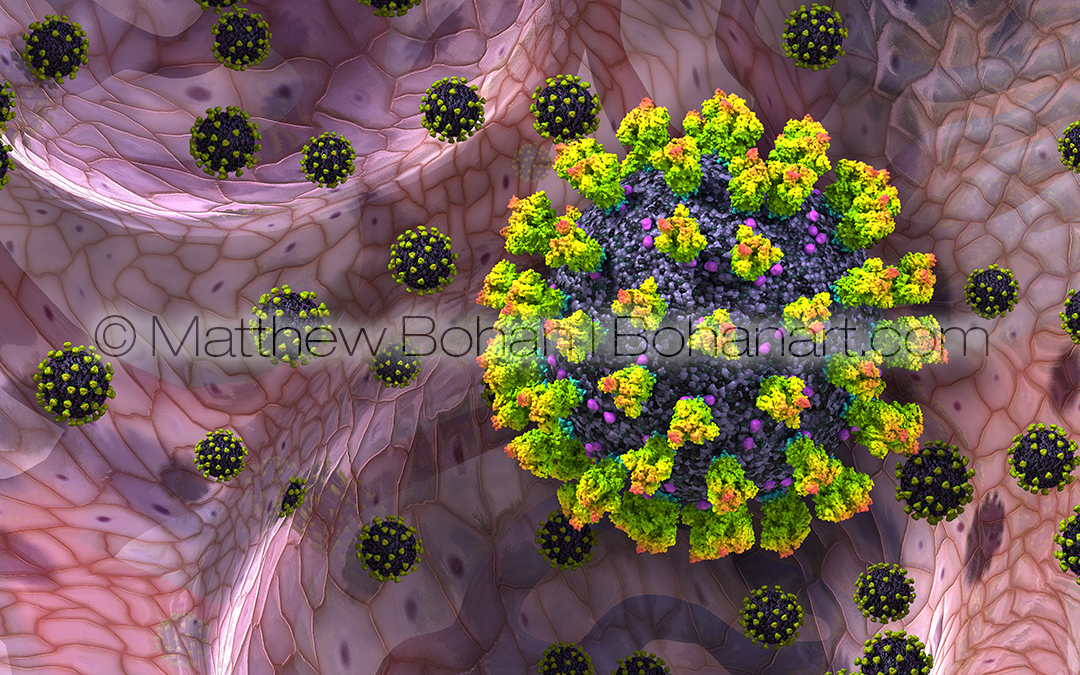
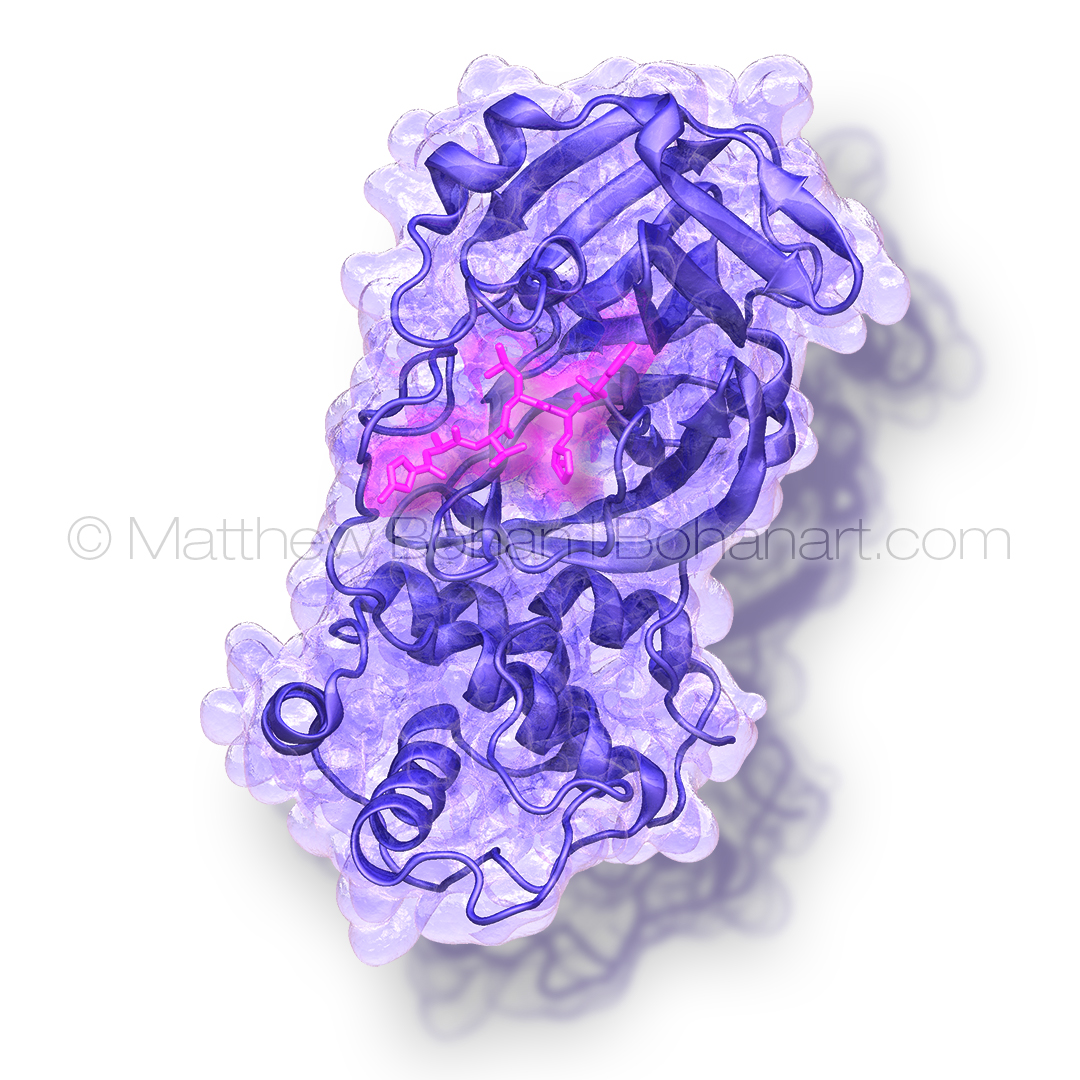
With a lull in my work schedule, I devoted some time to creating Coronavirus illustrations.
The top image shows coronaviruses in the alveolus of the lung.
The bottom image illustrates a single subunit of the newly discovered main protease of the COVID-19 strain. It is depicted in purple and shown in complex with a pink inhibitor. These proteins are from entry 6LU7 in the Protein Data Bank.
Both images are available for license. Vertical (portrait) formats are also available upon request.
Copyright © Matthew Bohan 3/11/2020
“The Coral Crew” Transparent Watercolor and Time-lapse Video
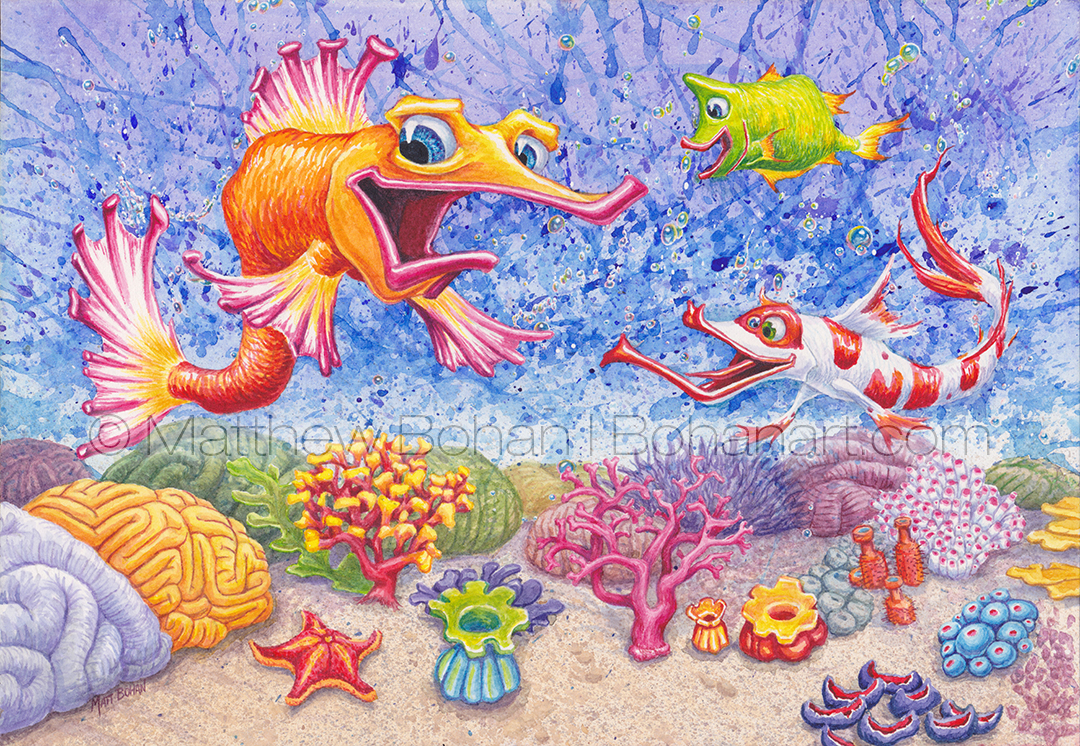
After a large, complicated, time-consuming botanical painting, I wanted something, small, fast and simple to work on. I sorted through a stack of doodles and composited a few into this coral reef scene. After the rigid realism of the last watercolor, it was refreshing to have no rules for working on this one!

